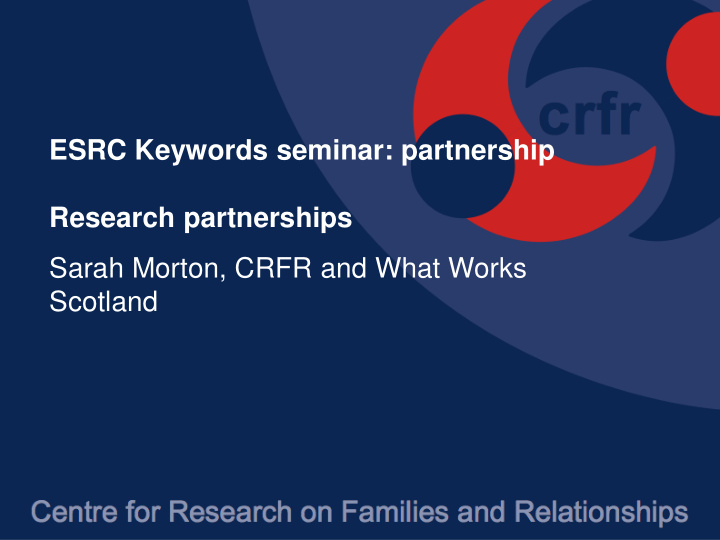



ESRC Keywords seminar: partnership Research partnerships Sarah Morton, CRFR and What Works Scotland
Background • 15 years of KE at CRFR • Case study of research partnership between NGO and CRFR • Many collaborative projects and practitioner research, evaluation • Current work with third sector to help use research
In this session • How can partnerships help research use? • What is co-produced research? • What do research partnerships look like? • Benefits and pitfalls • “Manifesto”
Challenges of research use: can collaboration help? Findings from a cross-sector review Its obvious in many of these that collaborations would help….
Research must be translated specifically targeted and open to discussion Third sector partners can help with translation
Enthusiasm: individual enthusiasts help carry the research Networking, creating expectations, championing the research
Contextual analysis : targeting specific barriers to and enablers of change Partnerships can help increase the available knowledge of context
Credibility : endorsement from opinion leaders and high levels of commitment Partnerships can add to credibility and trust
Leadership: strong visible leadership within organisations Partners can promote evidence-based ways of working
Support : financial, technical and emotional support – dedicated coordinators have been core to some initiatives Partnerships can help with press, technical etc
Integration : research impact activities need to be integrated into organisational systems. All key stakeholders need to be involved Through partnerships stakeholders are brought into the research
Summary of findings from the UK ESRC’s impact assessment activities • The most important drivers of impact are: – Established relationships and networks between researchers and research- user communities – Involving partners at all stages with research – Well-planned engagement and KTE strategies – Portfolios of research activity that build reputations with people who use research – The involvement of intermediaries and knowledge brokers as translators, amplifiers, network providers
So partnership helps… Lets explore partnership in more detail…..
Collaborative research Increased Increased understanding understanding of practice of research issues by processes by academics third sector Different kind of new knowledge created
Other benefits of research partnerships • Enable academics to communicate better • Bring local knowledge into research • Increase research skills in partner settings • Higher impact of research findings • Changing mindsets about what research is and how it can be used • Creating longer-term collaborations for mutual benefit
What do we mean by partnership? • Co-production, collaboration, partnership? “when academics and practitioners work together to carry out research” (Orr and Bennett 2010)
What kind of involvement? informant recipient Academic independence Impact endorser commissioner co-researcher (Martin 2010)
Co-researchers roles Tasks Develop agenda Get funding Define project Collect data Analyse data Engage stakeholders KE activities Continued use (Morton 2012)
Co-researchers roles Tasks Traditional roles Develop agenda shared Get funding shared Define project academics Collect data academics Analyse data academics Engage stakeholders partners KE activities partners Continued use both (Morton 2012)
Co-researchers roles Tasks Traditional roles CRFR/Childline Develop agenda shared shared Get funding shared shared Define project academics shared Collect data academics academics Analyse data academics shared Engage stakeholders partners shared KE activities partners shared Continued use both partners (Morton 2012)
Closer partnership: • Research highly relevant to policy and practice through funding, definition and analysis • Shared reporting honed relevant messages and increased contacts (more creativity) • Shared engagement with stakeholders increased credibility
Partnership issues • Neutrality v’s involvement • Political issues • Resources, space, time • Time to develop trust (without funding)
What helps research partnerships? • Agreeing mutually beneficial goals • Clarification of sharing of roles and resources • Attention to power dynamics • Mutual respect of complementary skills • Trust • Partnerships of choice, not convenience
Conclusions • Partnership research beneficial for both sides and increases research use and impact • Openness about roles and tasks helps
Thank-you! s.morton@ed.ac.uk
Recommend
More recommend